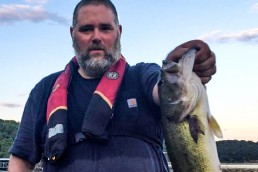Pre-Spawn into Spawn at Table Rock Lake
SHARE THIS POST
Table Rock Lake is an artificial lake known as a highland reservoir located in the Ozarks of Southwest Missouri. The Army Corps of Engineers completed a damn for flood control in 1958.
The normal pool of Table Rock Lake is 917 feet with a flood pool of 931 feet. The normal pool holds a vast 43,000-plus acres and the flood pool holds 52,000+ acres with depths reaching 200 feet.
Table Rock Lake is a popular attraction near the tourism mecca of Branson, Missouri. The lake is home to many marinas where patrons can rent boats, jet skis, and pontoons. The lake is fed by four major tributary river arms. The White River that is released from Beaver Lake, the Kings River, James River and Long Creek.
The lake varies according to season for surface water temperature.
- Spring: 56 to 77F
- Summer 85 to 90F
- Fall 71 to 82F
- Winter 42 to 47F
This variety of temperatures changes how the bass angler would acclimate their fishing tactics, bait types, and fishing locations. Table Rock Lake water clarity is well known to be clear. The normal visibility on the main lake can reach sometimes down 30 to 40 feet. The river arms are more stained with visibility sometimes down to 6 inches, especially after hard rains.
The bass spawn occurs in the spring but at different times. The water temperature and numbers of hours in the day have always been considered as characteristics for spawning periods. The overall health of bass here at Table Rock is superior.
The Table Rock Lake trifecta of bass
Table Rock Lake is viewed by anglers as the big trifecta of bass. The lake holds three types of black bass: largemouth bass, spotted bass (known locally as Kentucky bass), and smallmouth bass.
Largemouth bass
The largemouth bass is the most-hunted bass in the United States. You can find largemouth bass in an abundance of lakes and ponds. However, smallmouth bass and spotted bass are generally found in larger lakes and reservoirs such as Table Rock Lake. The largemouth population at Table Rock is whopping.
Spotted bass
Electrofishing surveys conducted in the spring of 2018 revealed an abundance of spotted bass in the 12 to 14-inch range, with four percent of the spotted bass captured in the spring surveys exceeding the minimum length limit of 15 inches. Many of these fish should reach legal size by 2019. The spotted bass are often found in the river arms by anglers.
Smallmouth bass
According to the Missouri Department of Conservation, largemouth and spotted bass comprise most of the black bass population in the river arms while smallmouth bass comprise a substantial segment of the black bass population in the main lake from the Highway 86 bridge to Campbell Point.
However, don’t be fooled, the river arms hold a great deal of smallmouths and have quality sizes.
Methodology
Baits can be fished, primarily, three separate ways—parallel to the bank; the traditional way set away from the bank and cast in; or using a drop-shot rig. My favorite way is parallel to the bank.
Parallel the bank
I set my boat as close to the bank as I can get it, sometimes I can reach out and touch the bank with my hand. I make forward casts parallel and as close to the bank as I can get. Next, I cast away from the bank about 1 foot. I will follow that up with another cast 5 feet from the bank. This technique will target those feeding fish while allowing you to keep the bait in a hot strike zone longer.
Are you enjoying this post?
You can be among the first to get the latest info on where to go, what to use and how to use it!
Parallel fishing will keep you from tangling up in buck brush, rocks and trees as bad.
Set away, cast in
This method has proven to work for millions of anglers for years. It’s a very effective way to catch fish. I set my boat in about 25 feet of water and cast inward. At times, I will allow my bait to drop in order to reach some deeper fish since you’re siting in deeper water.
Bass prefer to hide from other predators in deeper water and structure. Bass will hide in deeper water and move vertical in the water column to feed. The traditional set away from the bank and cast is key when bass rise in deeper water. Bass can feed in the middle of the lake all the way into the bank.
Drop shot
The drop-shot rig in Table Rock is fished year-round. The local guides on the lake are the best drop-shot anglers around. They target fish in a variety of ways and have great success of each.
The drop shot can be fished shallow, deep or in in between vertically in the water column.
Quality electronics enhance your ability to fish the drop shot. However, all electronics allow you to fish it successfully. The angler watches the bait in a vertical fashion under the boat and taunts the bass to bite the bait.
Pre-spawn
Here at the end of January, the water temperature is 45 degrees and below. As that water gets warmer and days get longer, the pre-spawn bite is on everyone’s mind. Bass tend to hold on main-lake structure rather to the tributary arms. They relate to the vertical and fast-sloping banks and structure. The also hold on Rock bluffs, channel swings, standing timber and 45-degree banks. Well, that’s about to change.
When that water temperature gets to that 45-degree mark, bass begin moving from deep water into the spawning banks. They still are holding deep compared to the spawn, but are frequently easy to find. Now it’s key to fish northern banks. Once you see temperatures reach 48 to 54 degrees, you’re in Pre-Spawn mode.
The crawfish are the main meal for bass this time of year. They have a great deal of protein in them. The fish movement are in ditches, tapered banks near shallow water, timber, deep contours and near pea gravel.
A craw-type bait will net you quality fish at this time. The craw pattern crankbait, jigs, and Neg rig are hot baits. The spinnerbait, chatterbait, and rattle traps can also do well in the shallow area near deep water.
Spawn
The spawn begins to happen when the days are longer and the water temperature reaches 55 to 65 degrees. Bass will be found in the pre-spawn mode still, but on flats and structure that is protected from winds and in 12 feet or less of water. Water clarity determines where fish will stage. In some of the crystal-clear water we have on Table Rock, bass could hold at 15 feet. In the more stained water, like in the river arms, bass can be holding at 1 foot.
Typically, the bigger bass spawn at the beginning of that 55-degree temperature range. Fishing shallow now with a jerkbait, spinnerbait, chatterbait, Ned rig, jig or worm could get you that wall hanger.
Bass are abundant here on Table Rock. During all seasons, bass will live in a variety of depths in the water column. I typically fish the winter pattern the same as the summer pattern and the same for spring to fall. This lake can beat you up from time to time. You can spend hours trying to get a bite and never catch anything. You will have those days where you can catch upwards of 50 fish. Focus on all the types of structures that are present here to your overall success.
MWO
SHARE THIS POST
Did you enjoy this post?
You can be among the first to get the latest info on where to go, what to use and how to use it!



